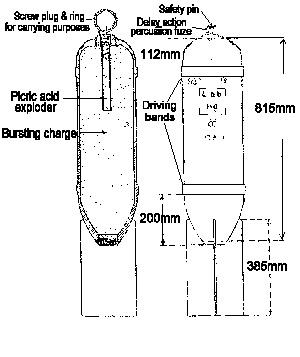|
During the war the Germans experimented with smooth-bore mortars, a number of which were produced, including one of 9.2-cm (3.6-in) calibre with ranges from 125 to 450 metres (137 to 492 yards).
Another specific type known as 'flugelminenwerfer,' i.e. firing vaned or finned projectiles, was adopted in calibres of 17, 18, and 24-cm (6.7, 7, and 9.45 inches respectively). These were also smooth-bore equipments, and notoriously dangerous to the detachments who always fired them with lanyards at least 50 feet (15 m) long!

Figure 19c
|
A number of obsolete bronze 18-cm (7.09-in) mortars seem to have been 'resurrected' and employed solely as poison gas projectors, their bombs being filled with either phosgene or a mixture of phosgene and chloropicrin, and burst by a small charge of TNT. Several hundred were said to have been discharged simultaneously against a target area. Weight of bomb was 29.4 kg (64.8 lbs) and range 1280 m (1400 yards).
The Russo-Japanese War also impressed upon the Germans the importance of the grenade in trench warfare, which probably prompted their production of the 'granatenwerfer' (grenade thrower), shown in Fig. 21. It is included here because the British designation is 'spigot mortar', the spigot being the protuberance over which the tail unit of the bomb or grenade is placed before firing. From the hole in the top of the spigot protrudes the firing pin which fires the primer of the cartridge housed in the tail.
After 1918 all German mortars became obsolete. Like the French the Germans seized upon the Stokes principle from which to develop a new range when they commenced re-arming prior to the outbreak of World War 2.

Figure 21
|
Return to top
previous |
index |
next
History index |
Home |
Wally Ruffell
|